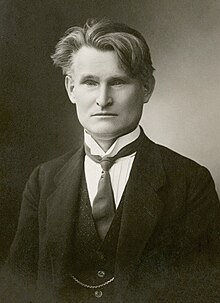Kazys Grinius
Kazys Grinius | |
|---|---|
 | |
| 3rd President of Lithuania | |
| In office 7 June 1926 – 17 December 1926 | |
| Preceded by | Aleksandras Stulginskis |
| Succeeded by | Jonas Staugaitis (Acting) |
| Personal details | |
| Born | 17 December 1866 Selema, Augustów Governorate, Russian Empire |
| Died | 4 June 1950 (aged 83) Chicago, Illinois, U.S. |
| Political party | Lithuanian Popular Peasants' Union |
| Spouse(s) | Joana Pavalkytė-Griniuvienė Kristina Arsaitė-Grinienė |
| Children | Liūtas Grinius (died 1989) |
| Alma mater | Imperial Moscow University (1893) |
Kazys Grinius ([kɐˈzʲiːs ˈɡʲrʲɪnʲʊs] , 17 December 1866 – 4 June 1950) was the third President of Lithuania, and held that office from 7 June 1926 to 17 December 1926.[1]
Early life
Grinius was born in Selema, near Marijampolė, in the Augustów Governorate of Congress Poland, which was part of the Russian Empire.
He studied medicine at the University of Moscow and became a physician. As a young man, he became involved in Lithuanian political activities, and was persecuted by the Tsarist authorities. In 1896, he was one of the founders of the Lithuanian Democratic Party (LDP) and Lithuanian Popular Peasants' Union (LVLS) party.
That same year he married Joana Pavalkytė. For some time they lived in Virbalis. In 1899, their son Kazys was born, and in 1902, their daughter Gražina was born. During World War I they lived in Kislovodsk. In 1918, during a Red Army attack his wife and daughter were killed. They were buried in Kislovodsk cemetery.
Career
When Lithuania regained its independence in 1918, Grinius became a member of the Constituent Assembly as a member of the Lithuanian Popular Peasants' Union party. He served as Prime Minister from 1920 until 1922, and signed a treaty with the Soviet Union.
He was elected President by the Third Seimas, but served for only six months, as he was deposed in a coup led by Antanas Smetona, under the pretext that there was an imminent communist plot to take over Lithuania. (Smetona took the Presidency after two others held the office for less than a day each.)
When Nazi Germany invaded Lithuania in 1941, Grinius refused to collaborate with the Germans because of his opposition to the occupation of Lithuania by any foreign power. He fled to the West, when the Soviet army reoccupied Lithuania in 1944, and emigrated to the United States in 1947.[1]
He died in Chicago, Illinois in 1950.[1] After Lithuania regained its independence in 1990, his remains were returned and buried there.
See also
References
- ^ a b c "Kazys Grinius". Encyclopædia Britannica. Retrieved 17 October 2009.
